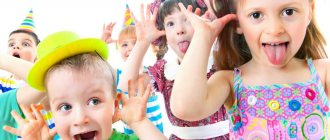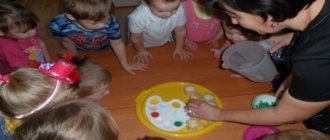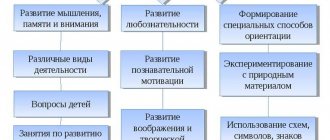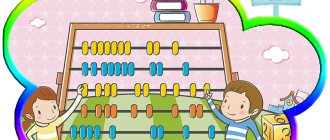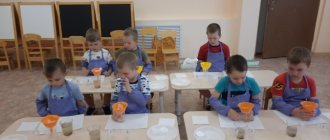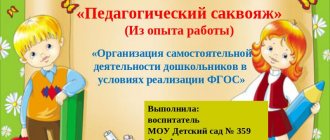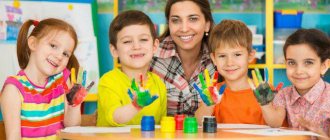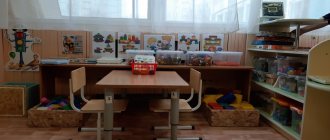Goals and objectives of development centers in the content of educational areas of the Federal State Educational Standard for Education
Goals and objectives of development centers in the content of educational areas
Social and communicative development
Games center (board games, role-playing games), a corner of solitude, a corner of local history, a labor center or a nature center, a traffic rules center or a safety, construction and design center.
Goals:
1.Development of children’s play activities in order to master various social roles, familiarize them with basic generally accepted norms and rules of relationships with peers and adults.
2. Formation of the foundations of safe behavior in everyday life, society, and nature. formation in preschoolers of the foundations of their own safety and prerequisites for environmental consciousness (safety of the surrounding world), the formation and assimilation by preschoolers of knowledge about safe behavior and the development of the ability to foresee danger in various changing situations.
3. Development of work activity, formation of moral ideas about work and gaining practical experience in work activity.
4. Patriotic education, education of spiritual and moral personality: the formation of patriotic feelings, love for the Fatherland, one’s people.
Tasks (FSES DO):
1. Assimilation of norms and values accepted in society, including moral and ethical values.
2. Formation of independence, purposefulness and self-regulation of one’s own actions.
3. Development of communication and interaction of the child with adults and peers.
4. Formation of a respectful attitude and a sense of belonging to one’s family and to the community of children and adults.
5. Formation of positive attitudes towards various types of work and creativity.
6. Development of social and emotional intelligence, emotional responsiveness, empathy
7. Formation of readiness for joint activities with peers
Speech development
Speech correction center, book center.
Goals:
1. Development of vocabulary, mastering the meanings of words and their appropriate use in accordance with the context of the statement, with the situation directly in which communication takes place.
2. Development of coherent speech.
3. Nurturing sound culture.
4. Formation of elementary awareness of the phenomena of language and speech.
5. Formation of the grammatical structure of speech.
6. Fostering love and interest in the artistic word.
Tasks (FSES DO):
1. Mastery of speech as a means of communication and culture.
2. Enrichment of the active vocabulary.
3. Formation of sound analytical-synthetic activity as a prerequisite for learning to read and write
4. Development of speech creativity.
5. Development of coherent, grammatically correct dialogical and monologue speech.
6. Acquaintance with book culture, children’s literature, listening comprehension of texts of various genres of children’s literature
7. Development of sound and intonation culture of speech, phonemic hearing.
Cognitive development
Educational center, science and experimentation center, nature center (labor center), mathematics center, book center, local history corner (Tatar corner)
Goals:
1. Acquaintance with the natural world and the formation of environmental consciousness.
2. Getting to know the social world.
3. Development of elementary mathematical concepts, intellectual development of preschool children, formation of methods of mental activity, creative and variable thinking based on mastering the quantitative relationships of objects and phenomena of the surrounding world.
Tasks (FSES DO):
1. Formation of cognitive actions, formation of consciousness.
2. Development of children's interests, curiosity and cognitive motivation.
3. Development of imagination and creative activity.
4. Formation of primary ideas about oneself, other people, objects in the surrounding world, about the properties and relationships of objects in the surrounding world (shape, color, size, material, sound, rhythm, tempo, space and time, etc.)
5. Formation of primary ideas about the small homeland and Fatherland, ideas about the sociocultural values of the people, about domestic traditions and holidays.
6. Formation of primary ideas about planet Earth as the common home of people, about the peculiarities of its nature, the diversity of countries and peoples.
Artistic and aesthetic development
Creativity center and art center, book center, musical instruments.
Goals:
1. Formation and development of aesthetic perception of the natural world, the formation of an aesthetic attitude of preschoolers to the natural world around them.
2. Formation and development of aesthetic perception of the social world, the formation of an aesthetic attitude of preschoolers to the world around them (respect for people, attitude to human relationships, the work of adults, etc.)
3. Formation and development of artistic perception of works of art, formation and development of interest in the content of works of art, understanding of its means of expression, as well as the emergence of value judgments, which can find expression in musical, theatrical and other types of activities.
4. Artistic activities (visual activities, modeling, appliqué, design from various materials, etc.), development of aesthetic perception, aesthetic sense and creativity of preschool children
.
Tasks (FSES DO):
1. Development of prerequisites for the value-semantic perception and understanding of works of art (verbal, musical, visual), the natural world.
2. Formation of an aesthetic attitude towards the surrounding world.
3. Formation of elementary ideas about types of art.
4. Perception of music, fiction, folklore.
5. Stimulating empathy for characters in works of art
6. Implementation of independent creative activities of children (visual, constructive-model, etc.)
Physical development
Sports Complex
Goals:
1. Acquisition by preschoolers of experience in motor activity, development in preschoolers of such physical qualities as flexibility, endurance, speed, balance, etc., contributing to the correct formation of the musculoskeletal system of the body, coordination of movement, and development of gross and fine motor skills.
2. The formation of purposefulness and self-regulation in the motor sphere, the formation and development in preschoolers of the ability to control their movements in the motor sphere.
3. Formation of healthy lifestyle values, formation of a healthy lifestyle worldview in preschoolers and instilling a culture of personal hygiene (daily routine, nutrition, body care, rest, etc.)
Tasks (FSES DO):
1. Development of various physical qualities.
2. Correct formation of the musculoskeletal system of the body, development of balance, coordination of movements, gross and fine motor skills.
3. Correct execution of basic movements.
4. Formation of initial ideas about some sports
5. Mastery of outdoor games and rules.
6. Mastery of basic norms and rules of a healthy lifestyle.
“organization of a board games center in a preschool educational institution”
Board Games Center.
The leading activity of a preschooler is play; with the help of it, the child learns about the world around him. It is generally accepted that a gaming deficit negatively affects the development of a child’s personality. A preschooler spends a significant part of his time in kindergarten among his peers, under the supervision of teachers.
Purpose
the creation of a board games center is the organization of an object-based gaming environment for the effective intellectual development of a child’s personality in a preschool educational institution. A special requirement is placed on the subject-game environment (what it reflects), since the environment is the main means of development of the child’s personality and the source of his knowledge and social experience. The nature of the game, the actions that the child performs, his feelings, and experiences largely depend on this.
A didactic game is a multifaceted, complex pedagogical phenomenon: it is a gaming method of teaching preschool children, a form of education, an independent gaming activity, and a means of comprehensive education of a child’s personality.
The general principle of activity inherent in didactic games opens up wide opportunities for solving didactic problems of different levels of complexity: from the simplest (assemble a pyramid with three single-color rings, put together a picture of two parts) to the most complex (assemble a Kremlin tower, a flowering tree from mosaic elements ).
Didactic games are:
- games with objects;
- desktop-printed;
- verbal;
- games with objects.
Environmental variability suggests:
− the presence in the group of various spaces (for play, construction, privacy, etc.), as well as a variety of materials, games, toys and equipment, ensuring the free choice of children;
− periodic change of play material, the emergence of new objects that stimulate the play, motor, cognitive and research activity of children.
Availability of the environment assumes:
— accessibility for pupils, including children with disabilities and children with disabilities, of all premises where educational activities are carried out;
− free access for children, including children with disabilities, to games, toys, materials, and aids that provide all basic types of children’s activities;
− serviceability and safety of materials and equipment.
The safety of a developing subject-spatial environment presupposes that all its elements comply with the requirements for ensuring the reliability and safety of their use.
As a study of practice shows, many teachers believe that the main thing in a kindergarten group is the creation of so-called “visual beauty and fullness.” With this approach to organizing the group environment, its content side and such a principle as ensuring the developmental influence of the environment on a preschool child are completely neutralized. The placement of materials should be functional, not display: it should be convenient for the child to take them and move them from place to place. The static, display “beauty” of the interior with toys and aids placed on the shelves of cabinets, often inaccessible to children, must give way to functional “beauty.” Materials should be stored in convenient and practical containers (plastic, cardboard, wooden boxes, baskets, etc.) with bright labels to make selection easier. When organizing a play space, complex, multifaceted and highly creative activities of teachers are required. After all, a variety of toys is not the main condition for the development of a child. The created aesthetic environment evokes in children a feeling of joy, an emotionally positive attitude towards kindergarten, a desire to attend it, enriches them with new impressions and knowledge, encourages active creative activity, and promotes the intellectual development of preschool children. When creating a playing space, you must:
− get rid of cluttering the space with low-functional and incompatible objects;
− create three object spaces for the child that correspond to the scale of the actions of his hands (scale “eye - hand”), growth and the object world of adults;
− proceed from the ergonomic requirements for life: the anthropometric, physiological and psychological characteristics of the inhabitant of this environment. Transformable furniture has recently become increasingly popular, allowing you to expand the playing space in accordance with the tasks performed. The play space of a group room is an integral part of a holistic educational environment. The development of a child depends on the subject environment to the same extent as on the adults raising him.
Didactic game as a gaming method of teaching
is considered in two types: games - activities and didactic (autodidactic) games. In the first case, the leading role belongs to the teacher, who, to increase children’s interest in the activity, uses a variety of gaming techniques, creates a gaming situation, introduces elements of competition, etc. the use of various components of gaming activity is combined with questions, instructions, explanations, and demonstration. With the help of games and activities, the teacher not only conveys certain knowledge, forms ideas, but also teaches children to play. The basis for children’s games are formulated ideas about the construction of a game plot, about various play actions with objects. It is important that conditions then be created for the transfer of this knowledge and ideas into independent, creative games, the proportion of which in a child’s life should be immeasurably greater than learning to play. Games are activities and therefore refer to the direct teaching of children using a variety of gaming techniques.
The didactic game is used in teaching children mathematics, their native language, familiarization with nature and the surrounding world, and in the development of sensory culture.
Didactic game as a form of teaching children
contains two principles: educational (cognitive) and gaming (entertaining). The teacher is both a teacher and a participant in the game. He teaches and plays, and children play and learn.
Didactic game as an independent gaming activity
based on awareness of this process. Independent play activity is carried out only if children show interest in the game, its rules and actions, if these rules have been learned by them. Children love games that are familiar to them and enjoy playing them. This can be confirmed by folk games, the rules of which are known to children (“Colors”, “We won’t tell you where we were, but we’ll show you what we did”, etc.). For example, in the game “Paints”, children need to choose any color of paint. Children usually choose their favorite and fabulous colors: gold, silver. Having chosen a color, the child approaches the driver and whispers the name of the paint in his ear. “Jump along the path on one leg,” says the driver to the one who named the color of the paint, which not one of the players chose. There are so many interesting play activities for children.
That's why children always play such games. The teacher’s task is to ensure that the children play independently, that they always have such games in stock, that they themselves can organize them, and be not only participants and fans, but also fair judges. The teacher takes care of complicating the games and expanding their variability. If the children’s interest in the game wanes (and this applies mostly to board and printed games), it is necessary to come up with more complex rules with them. Independent play activities do not exclude control by an adult. The participation of an adult is indirect; the teacher can be an equal participant in the game. Thus, in games, in addition to the formation of independence and activity of children, an atmosphere of trust is established between children and the teacher, between the children themselves, mutual understanding, an atmosphere based on respect for the child’s personality, attention to his inner world, to the experiences that he experiences during the game . This is the essence of collaborative pedagogy. In kindergarten, conditions must be created for a variety of games that ensure the comprehensive development of each child.
